Welcome to our comprehensive Jewelry Soldering Guide! This guide will provide you with the techniques, tools, and tips needed to achieve professional-quality soldering for your jewelry projects.
- Learn jewelry soldering techniques to create stunning and professional-looking pieces.
- Understand the fundamental tools and equipment for successful soldering.
- Create a safe and conducive workspace for effective soldering.
- Choose the right solder and learn to control heat for a seamless solder joint.
- Discover troubleshooting tips for common soldering problems and add intricate decorative elements to your jewelry.
Understanding the Basics of Jewelry Soldering
Soldering jewelry involves joining two metal pieces together using a metal alloy called solder.
Before you begin, it’s important to understand the basic tools and equipment you’ll need for soldering jewelry, such as a soldering iron, tweezers, and heat-resistant surfaces. You’ll also need to choose the right type of solder for your project, as different solders have different melting points and strengths.
Once you have your tools and materials, it’s time to learn some essential soldering techniques. Some common techniques used in jewelry making include sweat soldering, pick soldering, and chip soldering. Each technique requires a different approach, so it’s important to familiarize yourself with each one before beginning your project.
When soldering jewelry, it’s important to keep safety in mind. Always work in a well-ventilated area and wear protective gear such as safety glasses and heat-resistant gloves. Take the time to properly clean and prepare your materials before soldering to ensure a strong bond between the two pieces.
Soldering jewelry can be a rewarding and creative process, but it does take practice to master. With patience, attention to detail, and a willingness to learn, you can become proficient in this essential jewelry making technique.
Having the right tools and equipment is crucial for successful jewelry soldering. Here are the essential tools you will need:
- Soldering iron
- Soldering stand
- Flux
- Solder
- Tweezers
- Heat-resistant surface
- Heat-resistant gloves
- Safety glasses
It’s important to choose high-quality tools that will last. Cheap tools can break easily and may not give you the precision you need. Keep your tools organized and clean, and store them in a safe place.
When selecting a soldering iron, choose one with interchangeable tips so that you can use a variety of shapes and sizes to suit your project.
A soldering stand will hold your soldering iron securely when not in use. Flux is a chemical that helps the solder to flow smoothly, and solder is the metal alloy that bonds your jewelry pieces together.
Tweezers help you hold small pieces in place while soldering, and a heat-resistant surface protects your work area from damage. Heat-resistant gloves and safety glasses protect your hands and eyes from heat and other hazards.
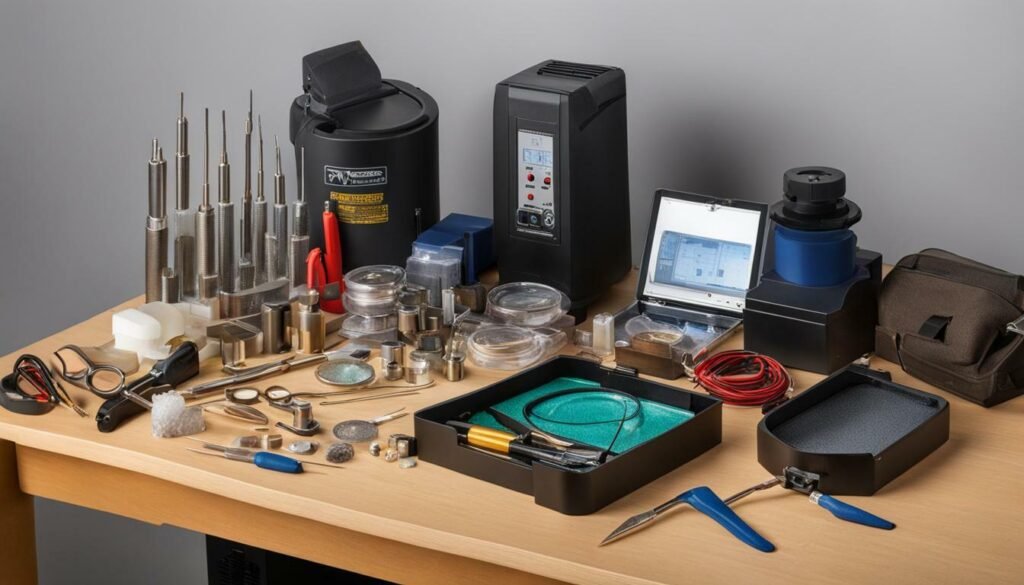
Exploring Soldering Techniques
Now that you have a basic understanding of jewelry soldering, it’s time to explore the different soldering techniques commonly used in jewelry making. These techniques require different levels of skill, precision, and equipment, so it’s important to choose the right one for your projects. Below are some popular soldering techniques to consider:
- Sweat Soldering: This technique involves heating two metal pieces until they are hot enough for solder to melt and flow between them. This technique is useful for joining two flat pieces of metal with minimal solder visible.
- Pick Soldering: In this technique, the solder is applied to a specific area with a pick and heated until it flows. It’s ideal for adding small components such as jump rings or delicate wirework to a piece of jewelry.
- Stick/Fillet Soldering: This technique involves applying solder to the joint and heating it until it melts and flows. It’s commonly used to create a strong bond between different metals or to mend a broken piece of jewelry.
- Plumbers’ Soldering: This technique requires a higher temperature and a larger torch to melt the solder. It’s ideal for creating larger joints or attaching heavier components such as clasps or hinges.
Creating a conducive workspace is crucial for successful jewelry soldering. Not only will it help you work efficiently, but it will also ensure your safety. Use these tips to prepare your workspace:
- Clean your workspace: Make sure your workspace is clean, clutter-free and well-lit to prevent any accidents or distractions.
- Organize your tools: Keep all your tools within reach and organized so that you can easily find what you need without having to search for them.
- Protect your work surface: Cover your work surface with a non-flammable material such as ceramic tiles to prevent damage from heat or accidental spills.
- Wear protective gear: Always wear protective gear such as safety glasses, gloves, and a dust mask to protect yourself from flying debris, heat, and fumes.
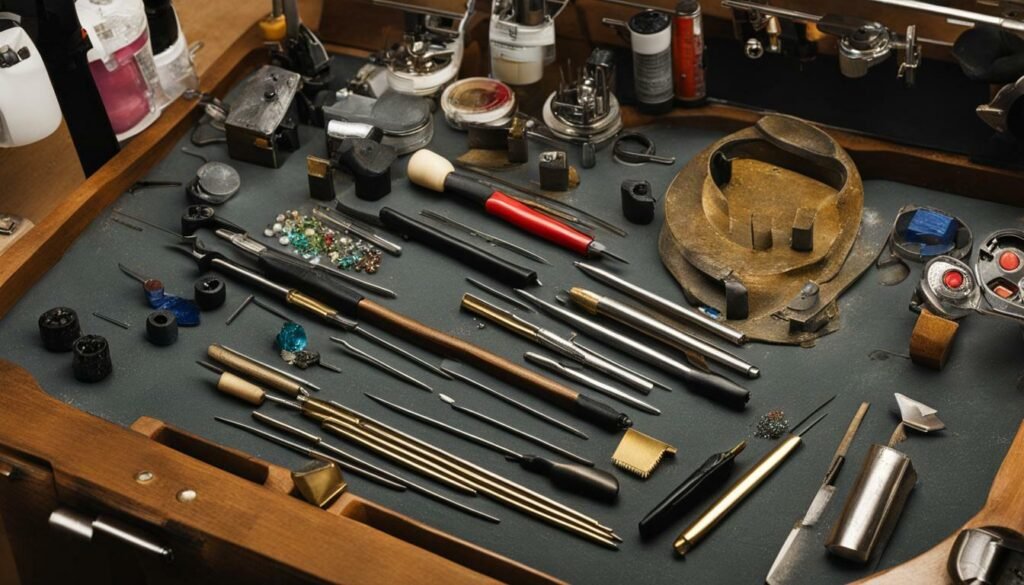
Choosing the Right Solder
There are various types of solder available, including easy, medium, and hard solders, each with different melting points. Here are some jewelry soldering tips to guide you in selecting the right solder for your projects:
- Consider the type of metal you’ll be soldering – certain solders work better with specific metals.
- Choose the solder with the appropriate melting point – you’ll want to ensure that the solder melts at a temperature that won’t damage your jewelry.
- Think about the solder’s color – some solders may have a different color than your jewelry, so you’ll need to choose a solder that will blend well with your piece.
- Experiment with different types of solder to determine which one works best for your jewelry projects.
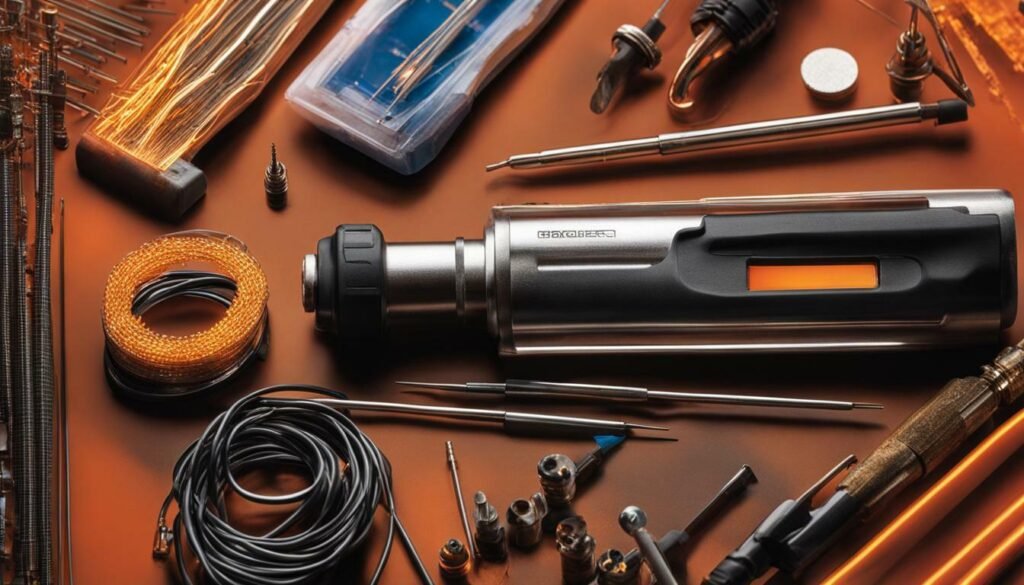
Before soldering your jewelry, it’s crucial to clean and flux your pieces to ensure successful bonding. Here are some tips to help you prepare your pieces for soldering:
- Use a wire brush or sandpaper to remove dirt, grease, and oxidation from the surface of your jewelry piece;
- Apply flux to the area to be soldered, either by painting it on or using a flux pen;
- Ensure you apply enough flux to cover the entire area but not so much that it drips or creates bubbles;
- Let the flux dry completely before starting the soldering process.
Mastering Heat Control
Controlling the temperature is essential in achieving successful soldering. If the temperature is too low, the solder will not flow, and if it’s too high, it can damage the jewelry.
Here are some jewelry soldering tips to help you master heat control:
- Use a soldering iron with adjustable temperature control to ensure precise and consistent heating.
- Learn the appropriate temperature for the type of solder you are using, as different solders require different melting points.
- Preheat the piece of jewelry before starting the soldering process to avoid thermal shock and warping.
- Heat the piece from underneath to avoid overheating the surface, which can cause discoloration or damage to delicate stones.
- Control the heat source by using a heat shield or a third hand to prevent the heat from affecting unwanted areas.

A seamless solder joint can make all the difference in the appearance of your jewelry piece. Here are some tips to help you achieve perfect solder joints every time:
- Ensure that your metal pieces fit together seamlessly before beginning the soldering process.
- Use the right amount of solder – too much can create an unsightly blob, while too little can cause a weak joint.
- Keep your workspace clean to prevent any dirt or debris from interfering with the soldering process.
- Use a fine-tipped flame to focus the heat on the specific joint rather than the entire piece.
- Apply the flux sparingly and evenly to ensure that the solder flows uniformly.
- Heat the piece slowly and evenly to avoid overheating and causing the joint or metal to melt.
- Use a third hand or tweezers to hold the pieces in place while soldering.
- Once the joint has cooled, clean it with a brass brush to remove any excess flux.
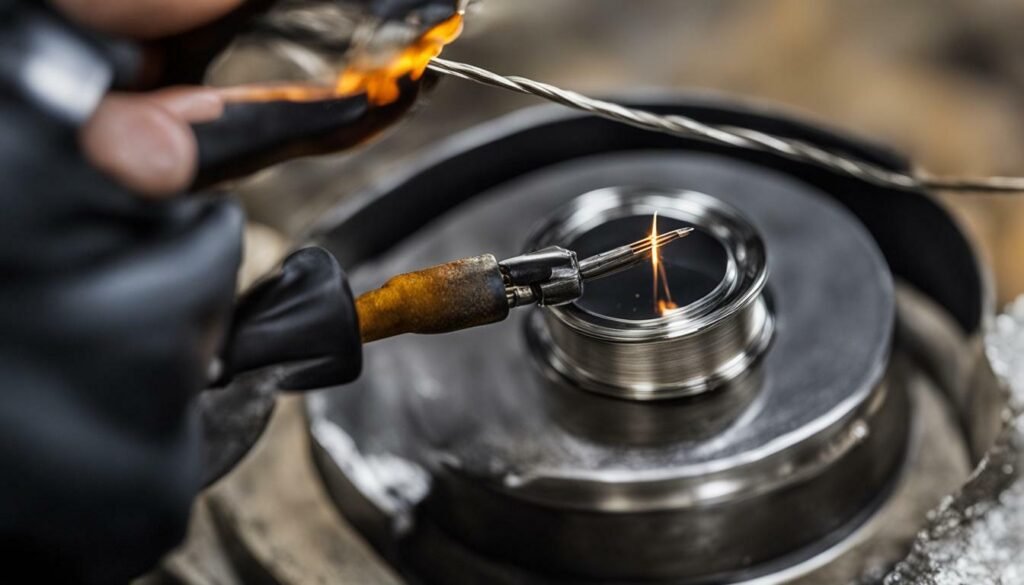
Despite your best efforts, soldering issues may still arise. Here are some troubleshooting tips to help you overcome common soldering problems:
- Solder not flowing: Ensure that the joint is clean and free of dirt and oxidation. Apply more flux and increase the heat until the solder flows.
- Solder balling: Use a smaller flame to decrease the heat and apply flux to the area before adding solder.
- Overheating: Use a smaller flame and adjust the heat to prevent the piece from melting or becoming distorted.
- Solder cracks: This could be due to a lack of flux or not heating the joint properly. Apply more flux and heat the area until the solder flows and forms a strong bond.
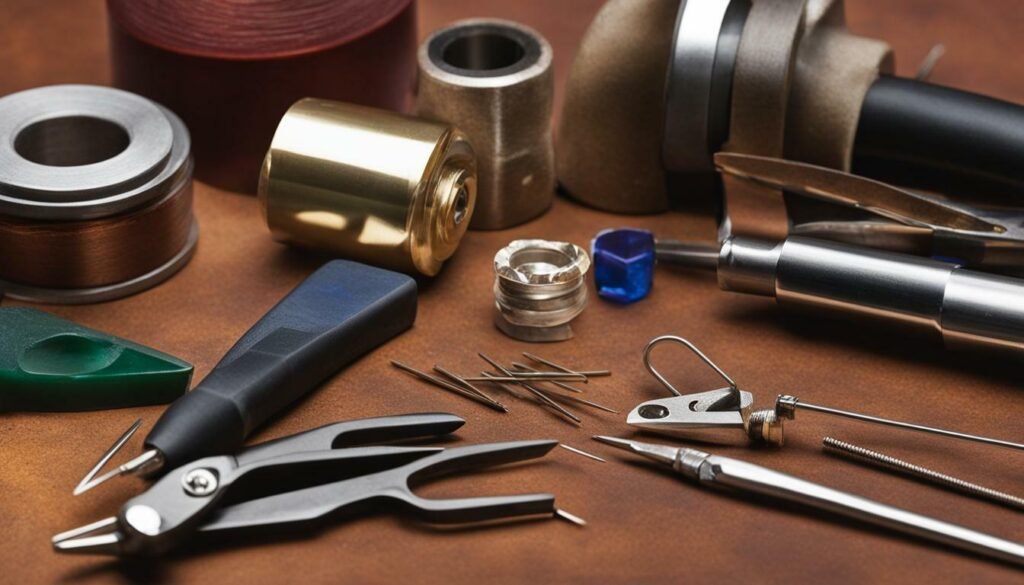
Adding Decorative Elements through Soldering
One of the joys of soldering is the ability to add intricate and decorative elements to your jewelry. Here are some techniques you can use to elevate your designs:
- Attach jump rings: You can use soldering to attach jump rings to pendants or other jewelry pieces, adding versatility and allowing for layering and customization.
- Create bezel cups: Soldering can also be used to create bezel cups, which can hold stones or other embellishments, giving your jewelry an elegant and unique touch.
- Add delicate wirework: Soldering is a great way to add delicate wirework to your jewelry, such as decorative filigree or twisted wire accents.
As a beginner to jewelry soldering, safety should be your top priority. Soldering involves high temperatures and electrical currents, so taking proper precautions is necessary to prevent accidents and injuries.
- Always wear safety goggles to protect your eyes from possible sparks or debris.
- Wear heat-resistant gloves to protect your hands from burns.
- Keep a fire extinguisher nearby in case of emergencies.
- Use a well-ventilated area or wear a respirator mask to avoid inhaling fumes and toxic substances.
In addition to safety gear, it’s important to handle your tools and materials with care. Here are some additional tips to keep in mind:
- When using a soldering iron, always keep it away from flammable materials and never leave it unattended.
- Store your tools and materials in a safe and organized manner when not in use.
- Make sure your workspace is clean and free of clutter to avoid tripping or knocking over materials.
- Keep children and pets away from your workspace to avoid accidents.
After successfully soldering your jewelry piece, it’s important to give it a final touch and ensure it’s clean and polished. Here are some tips to keep in mind:
- When finishing your piece, use a file to remove any excess solder that may be present and create a smooth surface.
- For cleaning, use a soft-bristled brush or cloth to remove any dirt or residue on your soldered piece. Avoid using harsh chemicals or abrasives that could damage the solder joints.
- Another option for cleaning is to use an ultrasonic jewelry cleaner. This machine uses high-frequency sound waves to clean jewelry without damaging the solder joints.
Even with the best soldering techniques, jewelry may still require repairs involving soldering. Here are some valuable tips for repairing broken jewelry through soldering:
- Before starting any repairs, make sure to clean the jewelry piece thoroughly to remove any dirt, grease, or debris that may hinder your repair process.
- Use the appropriate type of solder for the repair. If unsure, opt for a lower-temperature solder to prevent overheating the piece and damaging other components.
- Protect any delicate or heat-sensitive parts of the jewelry piece, such as gemstones or plastics, using heat shields or other protective materials.
- Use a magnifying glass or a jeweler’s loupe to inspect the soldered joint carefully after repair. Check for any cracks or unevenness and make adjustments if required.
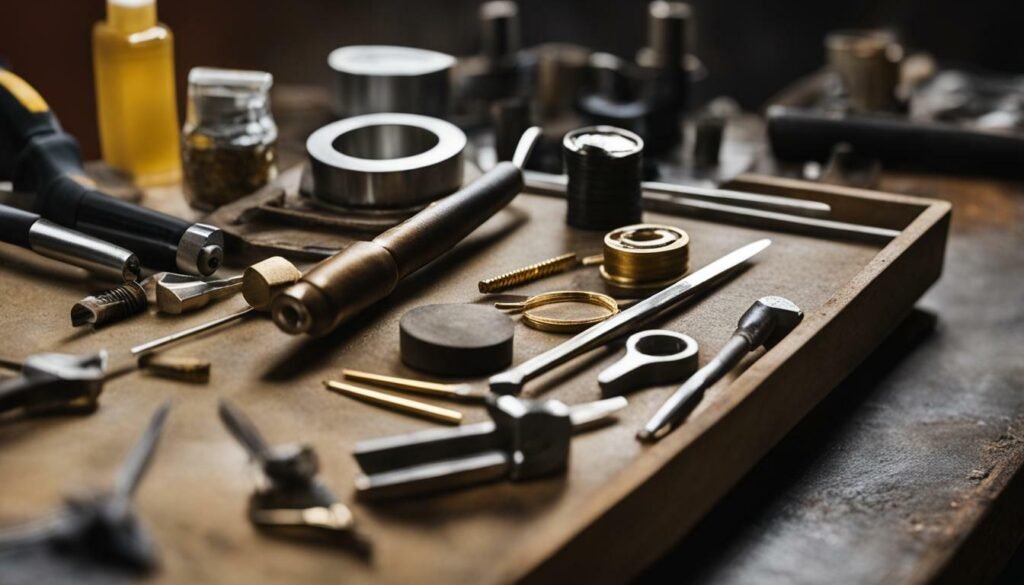
Here are some advanced jewelry soldering techniques to explore:
- Reticulation: A technique that involves heating the metal until a pattern of ridges and valleys emerges, giving the metal a distinctive texture.
- Granulation: A technique that involves attaching tiny balls of metal to a surface, creating a textured and decorative effect.
- Chain-making: A technique that involves creating custom chains from metal wire, adding complexity and uniqueness to your jewelry designs.
- Stone Setting: A technique that involves securing stones into jewelry pieces, adding a touch of elegance and sophistication to your work.

With the knowledge and techniques shared, you can create exquisite jewelry pieces with elegant precision at your fingertips. Here are some tips to help you embrace your creative journey:
- Experiment with different soldering techniques and tools to discover what works best for you.
- Explore new design ideas and challenge yourself to create unique pieces using the skills you have learned.
- Attend workshops or join a community of jewelry makers to share ideas and gain inspiration.
- Don’t be afraid to make mistakes; they are an inevitable part of the learning process and can lead to unexpected discoveries.
- Enjoy the process and take pride in the jewelry pieces you create.
FAQ
What is soldering?
Soldering is a technique used to join two or more metal components together using a molten metal alloy called solder.
What types of soldering techniques are commonly used in jewelry making?
Some common soldering techniques in jewelry making include sweat soldering, pick soldering, and chip soldering.
What tools and equipment are essential for jewelry soldering?
Essential tools for jewelry soldering include a soldering iron, soldering tweezers, flux, and a soldering block or pad.
How do I choose the right solder for my jewelry projects?
The choice of solder depends on the metals being soldered and the desired strength of the joint. Options include hard solder, medium solder, and easy solder.
How do I clean and flux my jewelry pieces before soldering?
Before soldering, it’s important to clean your jewelry pieces thoroughly using a jewelry cleaner or a mixture of vinegar and water. Then, apply flux to prevent oxidation and facilitate solder flow.
How do I achieve seamless solder joints in my jewelry?
To achieve seamless solder joints, ensure a tight fit between the metal components, apply heat evenly, and use the appropriate type and amount of solder. Fluxing and proper heat control are also crucial.
What are some common soldering issues and how can I troubleshoot them?
Common soldering issues include solder balling, inadequate flow, and solder cracks. Troubleshooting methods include adjusting heat, cleaning the joint, and using the correct soldering technique.
Can soldering be used to add decorative elements to jewelry?
Yes, soldering can be used to attach jump rings, bezel cups, and delicate wirework, among other decorative elements, to your jewelry designs.
What safety precautions should I take while soldering jewelry?
Safety precautions include wearing safety glasses, using a fume extractor or working in a well-ventilated area, and keeping flammable materials away from the soldering station.
How should I finish and clean my soldered jewelry pieces?
After soldering, you can use various techniques such as filing, sanding, and polishing to finish your jewelry pieces. Cleaning can be done using a jewelry cleaner or a mixture of mild soap and water.
How can I take my soldering skills to the next level?
To enhance your soldering skills, you can explore advanced techniques like reticulation and granulation, which can add unique textures and details to your jewelry designs.
